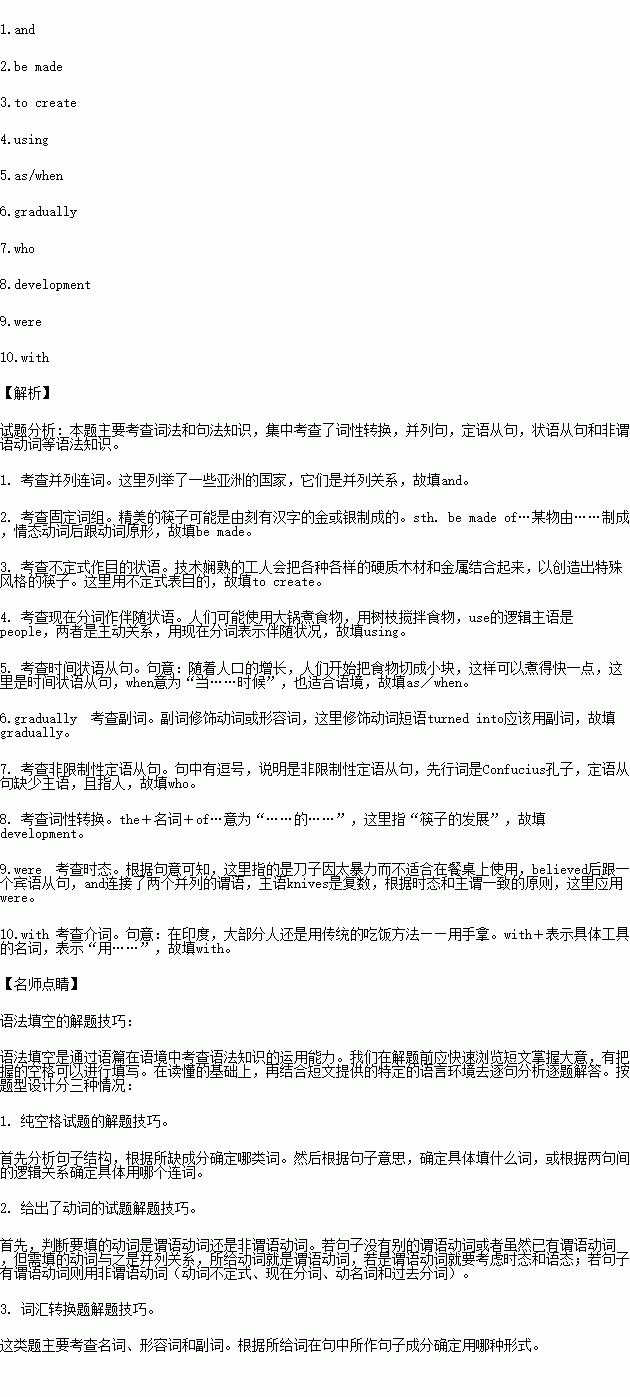题目内容
阅读下面材料,在空白处填入适当的内容(1个单词)或括号内单词的正确形式。
In much of Asia, especially the so-called “rice bowl” cultures of China, Japan, Singapore, Korea, 1. Vietnam, food is usually eaten with chopsticks.
Chopsticks are usually two long, thin pieces of wood or bamboo. They can also be made of plastic, animal bone or metal. Sometimes chopsticks are quite artistic. Truly elegant chopsticks might 2. (make) of gold and silver with Chinese characters. Skilled workers also combine(使……结合)different kinds of hardwoods and metal 3. (create) special designs.
The Chinese have used chopsticks for five thousand years. People probably cooked their food in large pots, 4. (use) twigs(树枝)to remove it. Over time, 5. the population grew, people began cutting food into small pieces so it would cook more quickly. Food in small pieces could be eaten easily with twigs which 6. (gradual) turned into chopsticks.
Some people think that the great Chinese scholar Confucius, 7. lived from roughly 551 to 479 B.C., influenced(影响)the 8. (develop) of chopsticks. Confucius believed knives would remind people of killing and 9. (be) too violent for use at the table.
Chopsticks are not used everywhere in Asia. In India, for example, most people traditionally eat 10. their hands.
 寒假学与练系列答案
寒假学与练系列答案阅读下列短文,从每题所给的四个选项(A、B、C和D)中,选出最佳选项,并在答题卡上将选项涂黑。
A
Gallery Policies for Visitors to National Gallery of Art, Washington | |
Visitors must present all carried items for inspection upon entry. After inspection, all bags, backpacks, umbrellas, parcels, and other things as determined by security officers must be left at the checkrooms, free of charge, close to each entrance.All oversized bags, backpacks, and luggage must be left at the checkrooms near the 4th Street entrance of either the East or West Building.These items will have to be x-rayed before being accepted.Items of value, such as laptop computers, cameras, and fur coats, may not be left in the checkrooms but may be carried into the galleries. We regret that we do not have enough space for visitor items larger than 17×26 inches into the Gallery or its checkrooms. Additional security procedures and checks may be taken according to the decision of the Gallery. | For the safety of the artworks and other visitors, nothing may be carried on a visitor’s back.Soft front baby carriers are allowed, but children may not be carried on shoulders or in a child carrier worn on the back.Pushchairs(童车) are available free of charge near each checkroom. Smoking is prohibited.Food and drink are not permitted outside the food service areas.Unopened bottled water may be carried only in a visitor’s bag.Cell phones may not be used in the galleries. Animals, other than service animals, are not permitted in the Gallery. Skateboarding is prohibited. Picture-taking (including video) for personal use is permitted except in special exhibitions and where specifically prohibited.Tripods (三角架) are not allowed. Please do not touch the works of art. |
1.When people come to visit the Gallery, they should _______.
A.leave all their carried items at the checkrooms
B.have all their carried items x-rayed at the entrance
C.take all their carried items with them without inspection
D.have all their carried items inspected at the entrance
2.Parents with small children visiting the Gallery __________.
A.can carry their children in soft front child carriers
B.can carry their children on their shoulders
C.can carry their children in carriers worn on the back
D.ought to pay if they want to use pushchairs for their children
3.Visiting photographers should make sure that _______.
A.pictures and videos are allowed for personal use anywhere in the gallery
B.pictures and videos can be taken in some places for personal use
C.picture-taking and videoing are totally forbidden in the Gallery
D.tripods are allowed except in some special exhibitions

